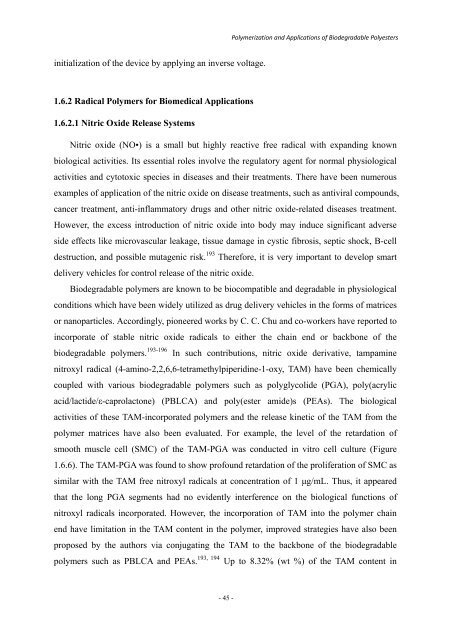Catalytic Synthesis and Characterization of Biodegradable ...
Catalytic Synthesis and Characterization of Biodegradable ...
Catalytic Synthesis and Characterization of Biodegradable ...
You also want an ePaper? Increase the reach of your titles
YUMPU automatically turns print PDFs into web optimized ePapers that Google loves.
initialization <strong>of</strong> the device by applying an inverse voltage.<br />
1.6.2 Radical Polymers for Biomedical Applications<br />
1.6.2.1 Nitric Oxide Release Systems<br />
- 45 -<br />
Polymerization <strong>and</strong> Applications <strong>of</strong> <strong>Biodegradable</strong> Polyesters<br />
Nitric oxide (NO•) is a small but highly reactive free radical with exp<strong>and</strong>ing known<br />
biological activities. Its essential roles involve the regulatory agent for normal physiological<br />
activities <strong>and</strong> cytotoxic species in diseases <strong>and</strong> their treatments. There have been numerous<br />
examples <strong>of</strong> application <strong>of</strong> the nitric oxide on disease treatments, such as antiviral compounds,<br />
cancer treatment, anti-inflammatory drugs <strong>and</strong> other nitric oxide-related diseases treatment.<br />
However, the excess introduction <strong>of</strong> nitric oxide into body may induce significant adverse<br />
side effects like microvascular leakage, tissue damage in cystic fibrosis, septic shock, B-cell<br />
destruction, <strong>and</strong> possible mutagenic risk. 193 Therefore, it is very important to develop smart<br />
delivery vehicles for control release <strong>of</strong> the nitric oxide.<br />
<strong>Biodegradable</strong> polymers are known to be biocompatible <strong>and</strong> degradable in physiological<br />
conditions which have been widely utilized as drug delivery vehicles in the forms <strong>of</strong> matrices<br />
or nanoparticles. Accordingly, pioneered works by C. C. Chu <strong>and</strong> co-workers have reported to<br />
incorporate <strong>of</strong> stable nitric oxide radicals to either the chain end or backbone <strong>of</strong> the<br />
biodegradable polymers. 193-196 In such contributions, nitric oxide derivative, tampamine<br />
nitroxyl radical (4-amino-2,2,6,6-tetramethylpiperidine-1-oxy, TAM) have been chemically<br />
coupled with various biodegradable polymers such as polyglycolide (PGA), poly(acrylic<br />
acid/lactide/ε-caprolactone) (PBLCA) <strong>and</strong> poly(ester amide)s (PEAs). The biological<br />
activities <strong>of</strong> these TAM-incorporated polymers <strong>and</strong> the release kinetic <strong>of</strong> the TAM from the<br />
polymer matrices have also been evaluated. For example, the level <strong>of</strong> the retardation <strong>of</strong><br />
smooth muscle cell (SMC) <strong>of</strong> the TAM-PGA was conducted in vitro cell culture (Figure<br />
1.6.6). The TAM-PGA was found to show pr<strong>of</strong>ound retardation <strong>of</strong> the proliferation <strong>of</strong> SMC as<br />
similar with the TAM free nitroxyl radicals at concentration <strong>of</strong> 1 μg/mL. Thus, it appeared<br />
that the long PGA segments had no evidently interference on the biological functions <strong>of</strong><br />
nitroxyl radicals incorporated. However, the incorporation <strong>of</strong> TAM into the polymer chain<br />
end have limitation in the TAM content in the polymer, improved strategies have also been<br />
proposed by the authors via conjugating the TAM to the backbone <strong>of</strong> the biodegradable<br />
polymers such as PBLCA <strong>and</strong> PEAs. 193, 194 Up to 8.32% (wt %) <strong>of</strong> the TAM content in

















